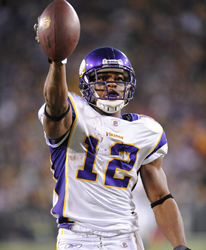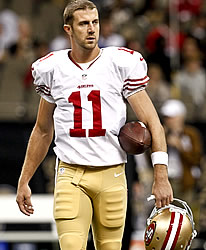 Quarterback Geno Smith performed well participating in all the drills, and his 4.59 speed was better than expected. He did enough to maintain his status as the draft’s top quarterback but didn’t overwhelm enough to make the case to be the first pick overall.
Quarterback Geno Smith performed well participating in all the drills, and his 4.59 speed was better than expected. He did enough to maintain his status as the draft’s top quarterback but didn’t overwhelm enough to make the case to be the first pick overall.
Mike Glennon and Tyler Bray displayed the best natural arms among quarterbacks. Bray really impressed with his throwing and may have inserted himself in the discussion to be the second quarterback selected. Teams will weigh his Combine performance against the inconsistency he showed on the field and his immaturity off of it. Glennon showed off his big arm but also his problems with accuracy and mechanics. His performance was as expected, which doesn’t necessarily hurt his stock but seems to push him from consideration as a first-round prospect. Glennon also needs to fill out his Olive Oil frame. The first hit he takes in the NFL may be his last.
His throwing isn’t as natural as the quarterbacks mentioned above, but E.J. Manuel also showed off a strong arm. He’s the most physically impressive also, standing at just under 6’5” with big hands and turning in the expected strong performance across the board in athletic tests, including a 4.65 40 time—second to Smith among quarterbacks. Manuel built off the momentum of a great Senior Bowl with an impressive Combine and, to me, has made the best case to be considered the second quarterback off the board, with potential to become the top quarterback picked if Smith slips in the next two months. His upside is that of a faster Daunte Culpepper with more accuracy on shorter throws.
A growing favorite of many pundits and draftniks heading in to the Combine, quarterback Ryan Nassib, was generating plenty of buzz before hitting Lucas Field. On it, he was solid but unspectacular. He had a few good throws, but his sudden media-generated reputation far exceeded his skills. Slow and shorter than ideal without a great arm, it’s hard to project him as more than a backup or placeholder.
Quarterback Collin Klein didn’t help his NFL future by declining to work out as a tight end. At best he’s a No. 3 quarterback on an NFL roster, but as he isn’t really a developmental prospect to be a future starter, he would be more appealing if he could bring some other things to the table.
Teams will be digging up old tape on running back Knile Davis to learn more about him. The former Arkansas runner broke out as a true sophomore in 2010, garnering All-SEC honors after leading the conference with 1,322 yards in Bobby Petrino’s offense. His collegiate career was derailed after a broken left ankle in a preseason scrimmage cost him the 2011 season. Davis returned a shell of himself in 2012. He couldn’t hold on to the ball, battled hamstring problems, appeared to run tentatively, and lost his starting spot when he struggled to find his place in the offense of new head coach John L. Smith. He had been tumbling down the running back rankings until the Combine. He ran a 4.37 40, the second fastest among running backs, and a ridiculous time for someone at 227 pounds. Davis was solid in the other tests, including 31 reps on the bench, and looked very good in the drills. The explosion and decisiveness he lacked during the season were back. A hard worker who was respected enough to be voted a team captain in 2011 despite not playing, he likely impressed in interviews too, which teams will have to weigh against his injury history. In addition to his hamstring problems last season and the broken left ankle that erased 2011, dating back to high school he has also broken his right ankle twice and his collarbone twice.
Building on the momentum of a strong Shrine Game performance, running back Christine Michael put together a portfolio of the best all-around test results among running backs and looked good in drills. However, he undid some of his work on Lucas Field by reportedly missing a couple of team interviews by oversleeping. As an isolated incident, it might not have been a big deal, but maturity and attitude questions linger after a poor relationship with his head coach last season. Considered one of the top prep runners coming in to college in 2009 (generally third behind Trent Richardson and Bryce Brown), Michael exploded as a true freshman for Texas A&M before injuries impeded his upward trajectory. A broken right leg after eight games in his sophomore season ended a strong encore, and a torn left ACL ended his junior year after nine games. In 2012, he struggled to get on the same page with new head coach Kevin Sumlin. Michael was relegated to a reserve and goal-line back role, while overshadowed by Heisman Trophy winning quarterback Johnny Manziel. The Combine showed that his talent clearly remains, but at what round does it outweigh attitude and injury concerns?
For a smaller back whose main upside was as a home-run threat, running back Andre Ellington tested poorly, including a disappointing 4.61 40 time. I really like what I’ve seen on the field through his career, but between a hamstring knocking him out of Senior Bowl week and now with this Combine, he is having a rough road to the draft since the season ended. I expect he’ll improve some of his numbers at his Pro Day, but this is very disappointing for a guy who I thought could come out of the Combine locking up a place among the top five running backs.
Running backs Montee Ball was solid, but unspectacular. He didn’t have to demonstrate pass protection, a weakness that could limit him to a two-down role early in his career. I appreciate the kids who decide to stay in school, but from a pure football decision standpoint, it is clear Ball should have come out last year. He put more wear on the tires without helping his draft stock. I had a similar solid, but unspectacular opinion of running back Giovani Bernard, but he appears to have impressed others more. Multiple sources report comparison of Bernard to Ray Rice by NFL scouts and execs. I don’t know if he made the case to pass the injured and absent Eddie Lacy as the top running back in the class, but he appears to have separated himself from Ellington and Ball as the number 2 back in this class.
While the consensus top-rated running backs in this class either ran in place or hurt themselves at the Combine, Johnathan Franklin climbed draft boards. He tested well and looked great in drills. After flying under the radar at UCLA most of his career, despite being a four-year starter, he overcame fumbling problems and put together his best season last year under new head coach Jim Mora Jr., who has heaped effusive praise on Franklin over the last year. Also significantly helping their cases were Le’Veon Bell and Kenjon Barner. The biggest pure running back at 230 pounds, Bell surprised with more speed than expected (a 4.6 40) and by catching the ball extremely well. He flashed more ability than the typical punishing, between-the-tackles runner, thus raising his ceiling. Barner tested well, but he really stood out in the receiving drills, running crisp routes and showing good hands. On the flipside, running back Stepfan Taylor failed to take advantage of the lack of separation by the other top-rated running backs. No one expected him to be a burner, but his 4.76 40 was worse than expected and he lacked explosion in drills.
The best all-purpose back looked like small-school running back Kerwynn Williams, who turned in one of the best all-around performances. The WAC record holder in all-purpose yardage tested well and turned heads in drills.


 We’ve updated the
We’ve updated the 
 Quarterback Geno Smith performed well participating in all the drills, and his 4.59 speed was better than expected. He did enough to maintain his status as the draft’s top quarterback but didn’t overwhelm enough to make the case to be the first pick overall.
Quarterback Geno Smith performed well participating in all the drills, and his 4.59 speed was better than expected. He did enough to maintain his status as the draft’s top quarterback but didn’t overwhelm enough to make the case to be the first pick overall.